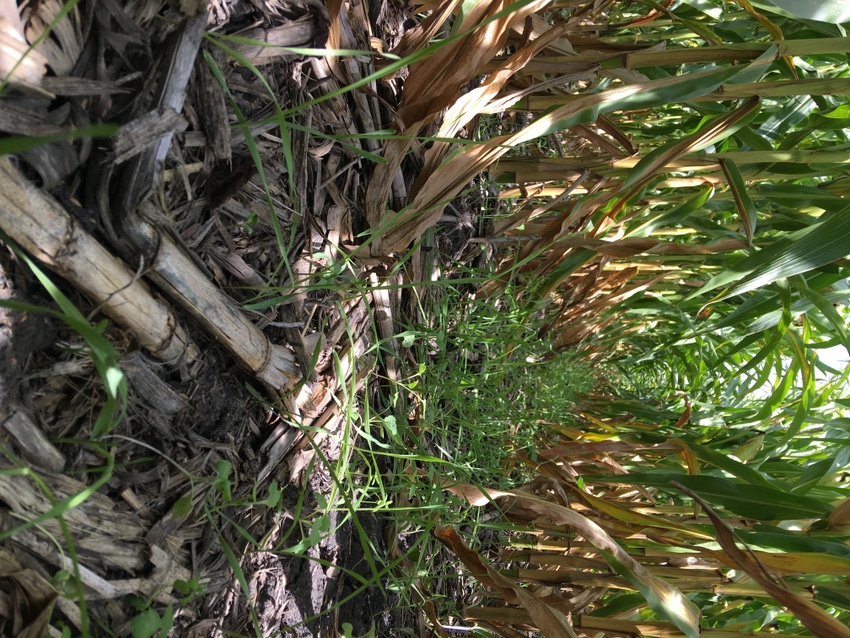September 2, 2016

When farmers and landowners think as much about their soil as they do their corn yields, the short- and long-term benefits are huge.
I asked three respected upper Midwest soil authorities for their top 10 thoughts on farming soil as a crop. All three thrive on the importance of good soil science that drives their tireless efforts to help farmers reduce/eliminate tillage and keep the soil biology well fed with cover crops in fall and spring.
If you’re familiar with the University of Minnesota/North Dakota State University joint research and education efforts on soil health, you probably know Dave Franzen, NDSU Soil Specialist; Jodi DeJong-Hughes, UMN Extension Educator; and Abbey Wick, NDSU Extension Soil Health Specialist. Their passions are infectious and valuable, to move soil health forward.
10 steps to farm your soil
Wick and DeJong-Hughes offer this advice for transitioning to a no-till/cover crop system.
1. Change the mindset from “I’ll give this a try” to “I’m going to make this work."
2. Don't do this alone. Find mentors who are successful at improving soil health with cover crops and strip till/no-till. It's imperative to have someone you trust to bounce ideas off of. Everyone has had setbacks and there’s no need to recreate the wheel. And stay out of the local coffee shops until you have a few years experience under your belt.
3. Learn about cover crops and replacing tillage. Some farmers think that using cover crops can shorten the transition time to less tillage, but Wick thinks it just makes it easier. To transition to less till, farmers need to figure out how to manage water first by using roots not tillage. For farmers in North Dakota, the year following wheat is the toughest because the soils are the wettest and there is a residue mat. Cereal rye is an excellent choice because it overwinters to use moisture in the fall and spring. It also helps control erosion. But never use cereal rye before a wheat crop and there can be yield hits to corn when cereal rye is not terminated 10-14 days prior to planting corn. Cereal rye can also tie up N and dry the soils out too much in a dry spring.
4. Attend regional meetings about cover crops and reduced/no-till/strip till to get more info before starting. Check to see if farmers are part of the agenda. Discussion time is key.
5. Incorporate cover crops first, and get familiar with that before you start no-till or strip till. For cover crops, keep it simple and choose 1-3 species fit for the time of year. Don't start with expensive mixes.
6. Try it on a small area of a few fields. Pick well-drained and lighter fields (maybe it's a mental trick, but whatever works!). Add patience. Water infiltration will improve very quickly with cover crops and less tillage, but improved soil health will take a few years.
7. Quit digging. That one’s easy, says Wick, as guys here in North Dakota are replacing tillage passes with cereal rye in the fall.
8. Examine tillage equipment needs. Get equipment tips from no-till/strip till farmers. It can be as simple as replacing disk openers more often so they achieve good seed-soil contact, or residue managers, or down pressure equipment, etc. Also, check if equipment manufacturers have a rental program, or if a strip till neighbor will do part of a field for you. Some companies have great deals right now. And learn what to expect when switching programs – from weed shifts to fertilizer banding.
9. Adjust crop rotations. Figure out how to fit the cover crops in a system. In corn you can interseed, aerial seed or drill cover crops. In some areas you can add a small grain crop back in rotation. If you make the same amount of money (when considering inputs, management and yields) on a cash crop per acre, then swap crops. By adjusting your rotation, you can fit in cover crops.
10. Never quit learning.
Check out these great resources:
Soil Health Institute: http://soilhealthinstitute.org
Soil health guides: http://bit.ly/SoilHealthGuides
UMN Soil Management: http://bit.ly/UMNsoilmgmt
NDSU Soil Health: https://www.ndsu.edu/soilhealth/
SARE Cover Crops and Soil Fertility: http://bit.ly/SAREcovercrops
CSD: How does tillage impact soil health: http://bit.ly/TillageSoilHealth
CSD: Profit from soil organic matter http://bit.ly/SoilHealthProfit
Begins with mindset adjustment
When I asked Dave Franzen about how farmers should think about farming soil as a crop, the North Dakota State University soil specialist responded by stating his blunt comments usually have him treading on thin topsoil.
“To get growers to farm soil like a crop, they first must acknowledge that there is a problem, which is harder than it sounds,” Franzen begins. “Every time the soil surface is dry, it blows. In the winter, growers who head south do not see the evidence of their fleeing soil in the black snow in ditches, fields and in town. When they return, there is a general attitude that it is an inconvenience – mostly a joke with their neighbors who are getting their soil. They don’t understand that the soil that lands nearby is only a small percentage of what was lost from their fields,” he says.
The second mindset adjustment, says Franzen, is to get growers to understand that no-till or modified no-till does not equal no-farming. “In really wet fall seasons, some crop is not harvested. This is perceived by some growers as no-till. It is not no-till. It is a wet part of a conventionally tilled farm that could not be harvested due to wet soil conditions.”
The next spring, Franzen says, it looks like no-till to neighboring growers, and sometimes if the spring is also wet, that area or field cannot be planted due to wet conditions. “Thus the phrase ‘no-till equals no-farm’. It is not prevent-plant due to no-till, it is prevent-plant due to wet soil conditions.”
During the past 20 years, the acreage of no-till in the central and northern part of the state, and even a vast acreage in Ransom/Sargent counties went back to conventional till because farmers thought the problem with wetness was their no-till. “What they learned during the subsequent years was that conventional till fields can be wet and can experience prevent-plant even worse than no-till fields,” he says.
“Farmers that hung on to their no-till have had no more loss due to water, and in many cases less loss due to water than their conventional till neighbors.”
About the Author(s)
You May Also Like






